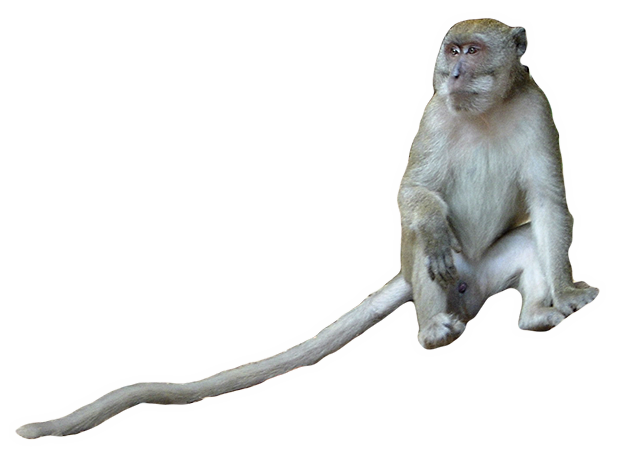
Khao Sok National Park
Between Phuket and Ranong in south Thailand lies one of the biggest and remarkable national parks on the Malay Peninsula - Khao Sok National Park. The landscapes are coined by these huge limestone mountains who form already the surroundings of Krabi and Phang Nga, by large tropical rainforests, rivers and lakes.
In the Forest
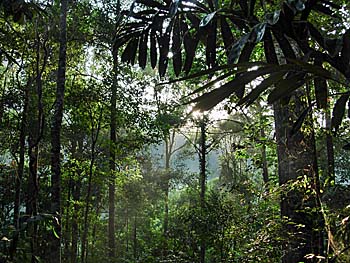
Inside the tropical rainforest of Khao Sok National Park. One has to go some kilometers inside to reach the primary forest core of the landscape. Image by Asienreisender, 2005
The phantastic looking mountains with their steep slopes were lifted up from the grounds of the Andaman Sea some estimated 60 to over 160 million years ago. About 300 million years ago the shallow oceanic waters were home to a gigantic corall reef which extended from south China down to Borneo. Part of the National Park is also Cheow Lan Lake, an artificial lake which ows it's existence to Ratchaprapha Dam. There are many caves and waterfalls in the park, bigger ones and smaller ones.
The area is one of the huge, forested landscapes where communist insurgents lived over years in the 1970s, namely after the brutal smashing of the student and intellectual movement in Thammasat University by the Thai army in Bangkok 1976.
Sok River
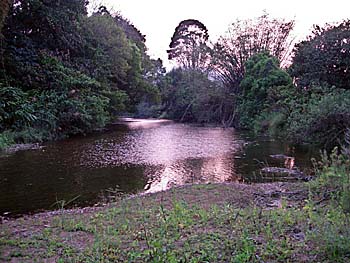
Evening at the river banks. Image by Asienreisender, 2005
The communist guerillas protected the nature from poachers, loggers, miners and the Thai army over seven years.
Khao Sok National Park was established as such in late 1980; the borders shifted later and comprise now 739km2. The highest peak in the park is Khao Mok (960m); most of the area is between 300m and 600m above sea level.
The climate is coined by the southwest as well as the northeast monsoon. Particularly the southwest monsoon brings plenty of rain from the Andaman Sea between early April to December. That's the reason why the forests here are evergreen tropical rainforests, in contrast to the forests in central and north Thailand, where long dry seasons let many trees loose their leaves and make them getting yellow and red colours.
The Tropical Rainforest of Khao Sok
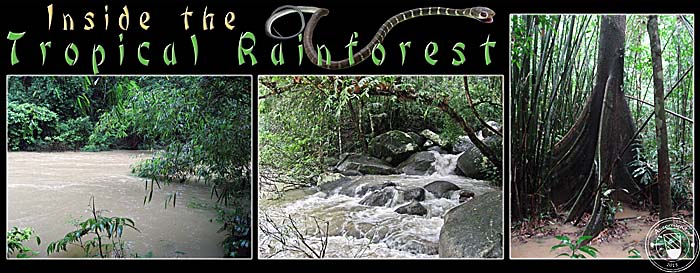
A rainy day in Khao Sok. There are many rainy days here, and on the slippy ground are masses of leeches who are extremely eager to creep up on one's legs. The streams and rivers swell up and one has to be double careful to make sure to find the way back.
The grand, old forest trees have huge buttress roots. Nowadays they are extremely seldom to see. All the old, big trees have been logged years ago. They are so valuable (here in monetary terms) that protection fails, business interests are always stronger. This tree here is merely a small one.
Images and photocomposition by Asienreisender, 2009, 2015
However, much of the tropical rainforest here is, despite the protection status, secondary forest, but considerable parts of it are still rare primary rainforest. The huge forest giants have large buttress roots who form the solid base for a stem which extends the upper forest canopy. A star among the flowers here is rafflesia kerrii Meijer (Thai: bua phut), with an 80cm blossom in diameter (see also: rafflesia arnoldii). Many kinds of bamboo are growing here; one of the main tracks is partially seamed by huge bamboo. Bamboo is a grass which appears in over 1,500 different kinds worldwide. There are also many kinds of fruit growing in Khao Sok National Park as durian, rambutan, jackfruit, mangosteen, bananas and more. Even wild pepper and ginger appear here and there.
Hiking in Khao Sok National Park
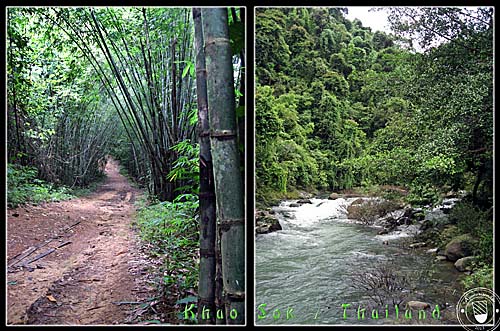
The main hiking track (left) is very easy to follow and no guide is required, so long one does not leave it. The way is seamed by large bamboo and ends up at the river right. Images and photocomposition by Asienreisender, 2009, 2015
Among the many here living animals are the Asian Elephant, different hornbills, some of them of the large kinds, leopards, wild boars, Malay bears, other bears, gibbons, langurs, dusky leaf monkeys, squirrels, mouse deer, barking deer, Malayan tapirs, macaques, king cobras, pit vipers, pythons, flying lizards and many, many more. A lot of birds live here and it's said there were still tigers living deep inside the forests; however, the last time a tiger has been seen here is long years ago. A lot of different dragonflies and butterflies are all around. Allegedly 5% of all global species are living in Khao Sok National Park, but I would be carefull believing such numbers. Fact is that these forests are among the oldest on earth, older than those in the Amazon basin of South America and allegedly richer in biodiversity than those (also arguably).
The Landscapes of Khao Sok
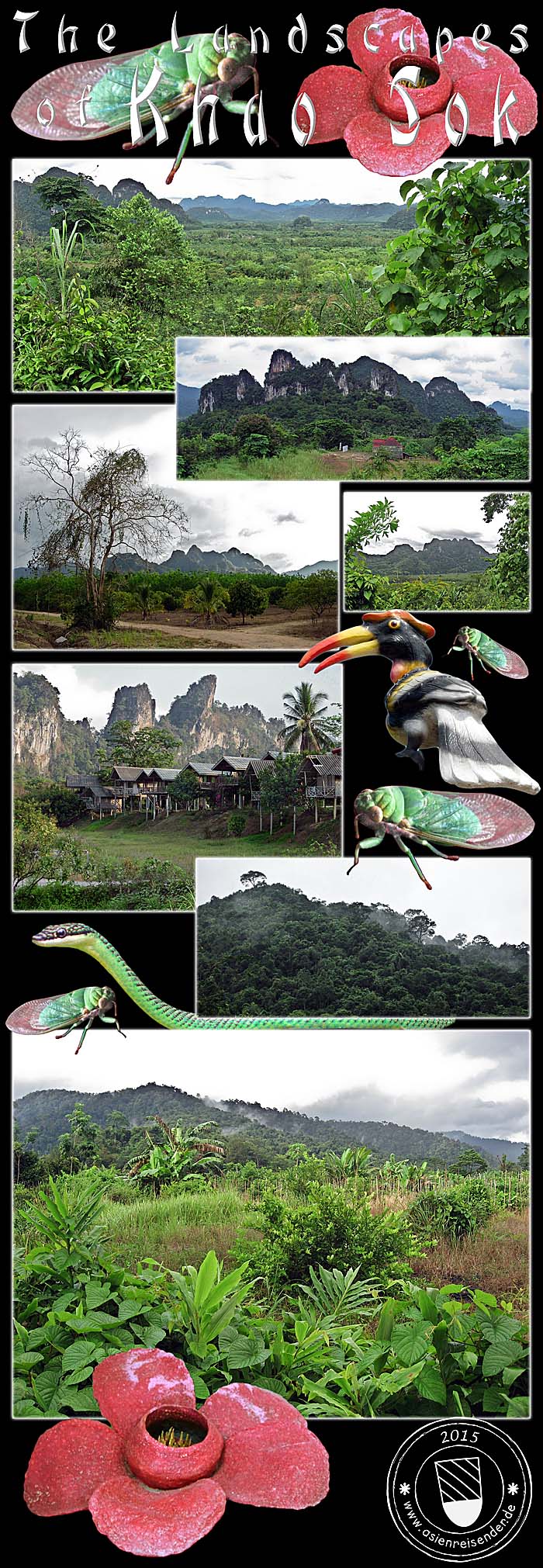
However the protection status of the national park is, there is permanent danger. From everywhere around civilization is creeping into the nature. The road, the resorts, the boats, the tourists, increasing traffic, rubber plantations, poaching... Images and photocomposition by Asienreisender, 2005, 2009, 2015
Cheow Lan Lake and
Ratchaprapha Dam
About 65km from the park's headquarter is the great Cheow Lan Lake. It's difficult to make the way; public transport is rare and runs only on the main road 401. From there to the lake it's another approximately 20km - I did it by hitch-hiking.
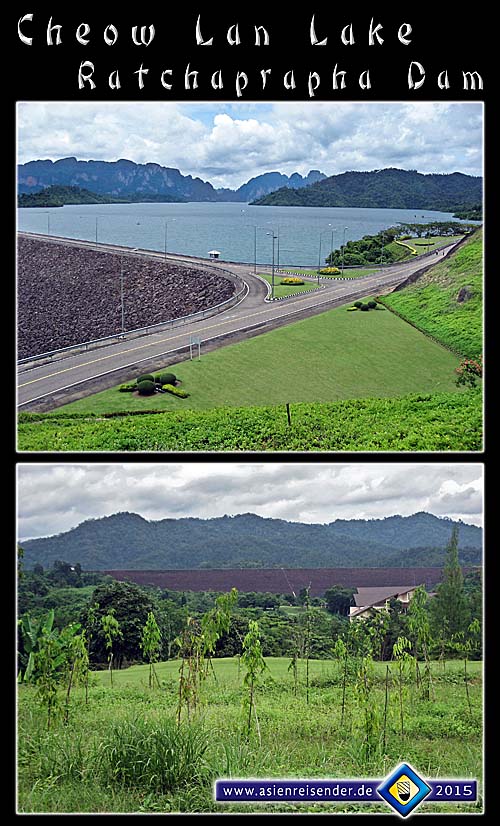
The grand dam with the huge artificial lake are a heavy impact in the formerly virgin landscapes of Khao Sok. Images and photocomposition by Asienreisender, 2009, 2015
Ratchaprapha dam has been built in 1982 and the lake ned three years to fill completely with water. It's fed by the Khlong Saeng River. The lake is in average 40m deep, at the dam 90m. The peaks of the many limestone mountains form more than 100 islands in the large lake. A huge area has been flooded in that time, and there was a rescue programme for part of the many animals who couldn't escape the flooding themselves. However, most animals nevertheless died and a 1995 research revealed the extinction of 52 river fish species who can not live in the lake.
Before the flooding, logging happened, but, wastefully, only the most valuable trees were cut. Others still point out of the water. 13 villages have been abandoned. The villagers received land for compensation along the route 401. The compensation also included an infrastructure like road, water, electricity access, school access for the children, a medical center, a community hall, a police station and a training in farming techniques. Each family got 19 rai (7.2 acres) to start a rubber plantation and a monthly income of 1.000 baht from the government.
Cheow Lan Lake comprises 165km2 and it's purpose is the generation of electricity. Behind the dam construction are the government of Thailand and Electricity Generating Authority of Thailand (EGAT).
Below the dam is a grand recreation area with roads, restaurants, hotels, parkings and a huge golf course. Along the shores of the lake are numerous raft houses shattered. They are reachable only by these typical Thai longtail boats (ruea hang yao). They offer food, beds and tours into the rainforest. Most of the food, particularly fish and other meat on the menu, is most probably from the lake or the forest, despite the protection. The extremely noisy longtail boats alone contribute to the pollution of the surroundings. The so called eco-tourism does not do the nature any good either. In fact there is no eco-business. Business is business and always based on the exploitation of nature and labour. Ecological is only not to touch the nature at all.
Peculiarities
In 1944 there was a lethal epidemic in the region. It's said that in Khao Sok village at the park entrance with the visitor center only 5 inhabitants survived. In 2009 there was still one of the survivors, an old women, alive in the village.
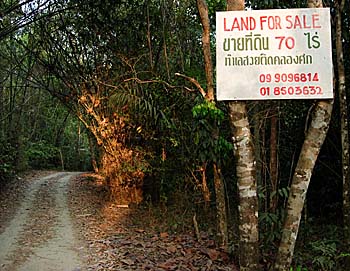
Destructive real-estate business is going on everywhere in Southeast Asia... Image by Asienreisender, 2005
The big road 401, which crosses the Malay Peninsula at this part from the west to the east coast at Suratthani, was first built in 1961 and massively extended around the year 2000.
Hiking in the park is easy and can be done without a guide, although the local guides claim it would be a problem. However, apart from two or three tracks one can follow for long, many other tracks are difficult to find. In 2005 I made my way alone deeper into the forest until a big pool with a small waterfall, where I could take a bath to refresh before turning back. It's of course crucial to remember the way one came from. Failing in that can cause great trouble - getting lost in the forest and being forced to spend a night there is no fun. The signs are usually incomplete, broken and do not help much. Quick weather changes make the surroundings looking suddenly very different.